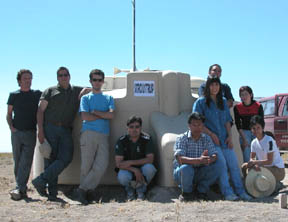 |
|
Tracking Down Cosmic Rays by Kurt Riesselmann The Pierre Auger Observatory, under construction in Argentina, became the largest cosmic-ray air shower array in the world with the completion of its one hundredth surface detector in October. Managed by Fermilab, the Pierre Auger project so far encompasses a 70-square-mile array of detectors that are tracking the most violent-and perhaps most puzzling- processes in the entire universe. Cosmic rays are extraterrestrial particles—usually protons or heavier ions—that hit the Earth's atmosphere and create cascades of secondary particles. While cosmic rays approach the earth at a range of energies, scientists long believed that their energy could not exceed 1020 electron volts, some 100 million times the proton energy achievable in Fermilab's Tevatron, the most powerful particle accelerator in the world. But recent experiments in Japan and Utah have detected a few such ultrahigh energy cosmic rays, raising questions about what extraordinary events in the universe could have produced them.
Scientific theory can account for the sources of low- and medium-energy cosmic rays, but the origin of these rare high-energy cosmic rays remains a mystery. To identify the cosmic mechanisms that produce microscopic particles at macroscopic energy, the Pierre Auger collaboration is installing an array that will ultimately comprise 1,600 surface detectors in an area of the Argentine Pampa Amarilla the size of Rhode Island, near the town of Malargüe, about 600 miles west of Buenos Aires. The first 100 detectors are already surveying the southern sky. "These highest-energy cosmic rays are messengers from the extreme universe," said Nobel Prize winner Jim Cronin, of the University of Chicago, who conceived the Auger experiment together with Watson. "They represent a great opportunity for discoveries." The highest-energy cosmic rays are extremely rare, hitting the Earth's atmosphere about once per year per square mile. When complete in 2005, the Pierre Auger observatory will cover approximately 1,200 square miles (3,000 square kilometers), allowing scientists to catch many of these events. On the Web:
Pierre Auger Observatory |
| last modified 11/25/2003 email Fermilab |
FRLsDFx9eyfrPXgV
